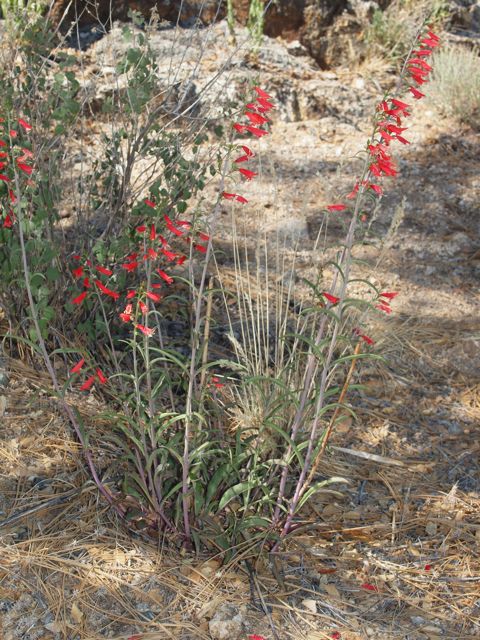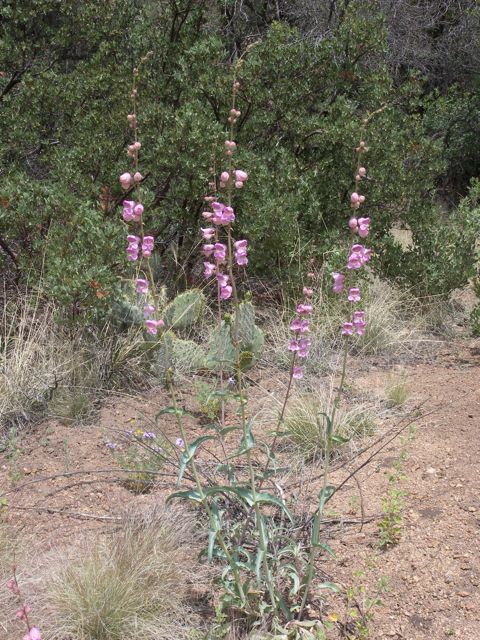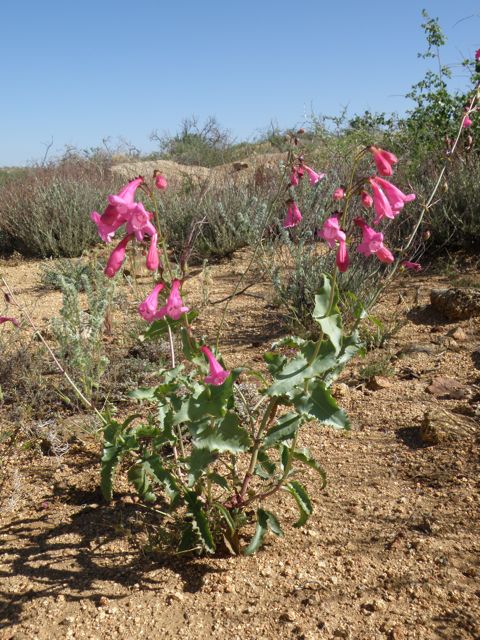 Colorful Penstemons are Tough Cookies - February 14, 2018 Jeff Schalau, Agent, Agriculture & Natural Resources University of Arizona Cooperative Extension, Yavapai County Penstemons are a natural choice for informal, water conserving landscapes. Some commercial growers have been propagating these perennials collected from wild populations in the western United States and northern Mexico. Like snapdragons, penstemons belong to the Figwort family (Scrophulariaceae). The flowers bloom in spring and early summer. They attract hummingbirds and range in color from orange to red, to purple, to white, and everything between. Their growth form ranges from low-growing ground covers with short flower spikes to medium sized plants that produce tall flower spikes. Penstemons have tubular flowers with tri-lobed petals jutting outward from the lower part of the corolla, hence the common name: beard tongue. Penstemons are spring bloomers and look best in rock gardens or planted among desert shrubs or cactus. They prefer well-drained, sandy soils, full sun, and are very drought tolerant once established. Some irrigation may be required during extended drought periods, especially to keep young seedlings alive. Soil preparation with organic amendment can improve establishment. Do not apply fertilizers. Following establishment, seeds will germinate and your Penstemons will naturalize if left undisturbed and weed competition is managed. Seedlings grow slowly for the first year and established plants can live for three or more years. Below is a short list of Penstemons native to or suitable for planting in north central Arizona. When growing Penstemons from seed, be sure to cold stratify the seeds prior to sowing to ensure winter chilling that will seed break dormancy. A simple stratification method is to put seeds between layers of moist paper towel inside a partially sealed zip lock bag and place the bag in the refrigerator for one or two months. Make sure the paper towel stays moist but not wet and sow the seeds gently in pots or prepared soil. Below are a few of the Penstemon varieties suitable for planting in north central Arizona. Red Penstemon (Penstemon barbatus) has brilliant scarlet flowers borne in profusion on 2-4 ft. stalks. Hummingbirds love it. Needs well-drained soil. Firecracker Penstemon (P. eatonii) is a low growing, shrubby, evergreen perennial that blooms in late winter and early spring. It forms a small, dark green mound to 1 foot-tall by 2 feet wide, with fiery scarlet-red flower spikes adding another 2 feet in height. It has dark green, lance-shaped leaves are 1 inch-wide and up to 5 inches long. Parry's Penstemon (P. parryi) is a spring-flowering perennial with light to dark pink or sometimes white flowers. The plant consists of a low rosette of leaves, usually less than 10 inches high, and flower stalks that can reach 4 feet tall. In time, the plant can reach a width of about 2 feet. The dark gray-green leaves are up to 4 inches long. Parry's Penstemon is native to the lower deserts of Arizona. Scented Beardtongue (P. palmeri) is fragrant and bears a profuse display of large white blooms tinged with pink or lilac. This huge plant has many flower stalks reach 5-6 ft. Can bloom the first season from seed. Arizona Penstemon (P. pseudospectabilis) has shocking pink flowers are borne in profusion on this robust, bushy, 3-4 ft. tall plant. The blue-green, triangular leaves are fused together around the stem. Blooms in spring and again more lightly in summer. Hill Country Penstemon (P. triflorus) is a bushy, upright perennial to 2 feet tall, with glossy green leaves. The large, 1 ½ inch long, deep pink flowers are funnel-shaped with 5 lobes. These lobes are strongly marked with dark lines, which are believed to attract pollinators to the nectar at the base of the tube. The flowers occur in clusters of 3 along the flower spike. Penstemons are a favorite in my landscape and I encourage you to get some going. I also search for them in wildlands where they can be found at almost any elevation across northern Arizona. I’ve also included a few photos and links to additional information with the online edition (see URL below). The photos are from Yavapai County Native & Naturalized Plants, a website created and managed by Yavapai County Master Gardeners and is available at: https://cals.arizona.edu/yavapaiplants/. Follow the Backyard Gardener on Twitter – use the link on the BYG website. If you have other gardening questions, call the Master Gardener help line in the Camp Verde office at 928-554-8992 or e-mail us at verdevalleymg@gmail.com and be sure to include your name, address and phone number. Find past Backyard Gardener columns or provide feedback at the Backyard Gardener web site: http://cals.arizona.edu/yavapai/anr/hort/byg/. Photos  Red Penstemon (P. barbatus) in bloom (photo by Sue Smith from: Yavapai County Native & Naturalized Plants: https://cals.arizona.edu/yavapaiplants/SpeciesDetailForb.php?genus=Penstemon&species=barbatus).
Red Penstemon (P. barbatus) in bloom (photo by Sue Smith from: Yavapai County Native & Naturalized Plants: https://cals.arizona.edu/yavapaiplants/SpeciesDetailForb.php?genus=Penstemon&species=barbatus). Scented Beardtongue (P. palmeri) in bloom (photo by Sue Smith from: Yavapai County Native & Naturalized Plants: https://cals.arizona.edu/yavapaiplants/SpeciesDetailForb.php?genus=Penstemon&species=palmeri).
Scented Beardtongue (P. palmeri) in bloom (photo by Sue Smith from: Yavapai County Native & Naturalized Plants: https://cals.arizona.edu/yavapaiplants/SpeciesDetailForb.php?genus=Penstemon&species=palmeri). Arizona Penstemon (P. pseudospectabilis) in bloom (photo by Sue Smith from: Yavapai County Native & Naturalized Plants: https://cals.arizona.edu/yavapaiplants/SpeciesDetailForb.php?genus=Penstemon&species=pseudospectabilis).
Arizona Penstemon (P. pseudospectabilis) in bloom (photo by Sue Smith from: Yavapai County Native & Naturalized Plants: https://cals.arizona.edu/yavapaiplants/SpeciesDetailForb.php?genus=Penstemon&species=pseudospectabilis).Additional Resources Penstemon: A colorful choice for water wise gardening Colorado State University Extension extension.colostate.edu/topic-areas/yard-garden/penstemon-a-colorful-choice-for-water-wise-gardening/ American Penstemon Society penstemons.org |